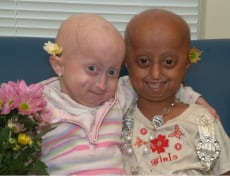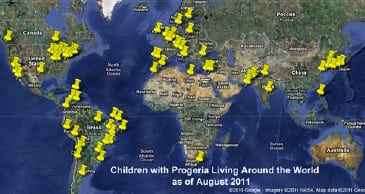 |
| Children like 10-year-olds Meghan (left) and Sumaira, who suffer from the premature aging disease Progeria, have a better chance at survival thanks to clinical trials generated by the Find the Other 150 campaign. Photo courtesy of The Progeria Research Foundation |
Organization: Progeria Research Foundation
Agency: Spectrum/GLOBALHealthPR
Timeframe: Oct. 2009 - Oct. 2010
Hutchinson-Gilford Progeria Syndrome (“Progeria,” or “HGPS”) is a fatal genetic condition characterized by an appearance of accelerated aging in children. Its name is derived from the Greek language and means “prematurely old.” Progeria is rare, with reported incidence of about one in 4-8 million newborns. But that is no solace to the children and families affected. All children with Progeria will die of the very same heart disease that affects millions of normal aging adults (arteriosclerosis), but at an average age of 13 years.
As of October 2009, just 54 children in 30 countries had been diagnosed with Progeria, but experts estimated that another 150 children worldwide had yet to be diagnosed or identified. Because it’s one of the world’s most rare diseases, physician knowledge of Progeria and how to care for these children is often limited. As a result, the children and families are left without help or information.
Enter the Progeria Research Foundation (PRF) and Spectrum, its longtime pro-bono communications partner. PRF was a driving force behind the identification of the Progeria gene nearly 10 years ago, a discovery that Spectrum trumpeted to the world. “We’re science geeks and like being part of big discoveries,” says John Seng, founder, president and CEO of Spectrum.
Since then the Washington, D.C.-based communications agency has focused on building awareness of Progeria and promoting support of the foundation and its causes, says Seng.
SEARCH FOR THE 150
In fact, it was Seng’s idea in 2009 to find those other 150 children with Progeria. Why? Finding these children would help scientists improve their understanding of Progeria, contributing to potential development of new treatment options for Progeria and potentially, for cardiovascular disease more broadly. Furthermore, the search would provide hope and support to families whose lives were affected by the disease.
But finding these children would not be easy—it would take a truly global effort and even then it would be like finding a needle in a haystack.
Spectrum, in partnership with its network of global health communications firms, GLOBALHealthPR, conceived the Find the Other 150 campaign. “Even if we found one kid, it would be worth it,” says Seng. Ultimately they would do much better than finding just one.
The campaign, then, had the following objectives:
• Increase awareness of Progeria worldwide
• Find even one child with Progeria worldwide
• Position PRF as the global resource for information on Progeria
The effort would have a primary audience of families and friends of kids who may have Progeria; the secondary audience would be doctors and other healthcare professionals who may be struggling with diagnosing a child who may have Progeria. From the PRF’s point of view, it was critical to find the kids, make an accurate diagnosis and have them and their families participate in wellness programs, says Audrey Gordon, president, executive director and co-founder of PRF. “It’s exciting for us and exciting for the families,” says Gordon.
DISEASE WITH A FACE
For better or for worse, the media is attracted to Progeria stories, says Seng. Three elements make it a hard story to resist: It involves kids, it’s one of the rarest diseases known to man and you can see the effects of the disease. And that third element would play heavily into the Find the Other 150 campaign. “The symptoms and manifestations of Progeria are very easily visually identified, even across ethnicities,” says Seng. Hence, the goal was for families of children who many have Progeria to “see their children’s faces” in the images provided through media coverage within 10 countries around the world.
The campaign would have a “quest” theme, like a search for a missing child, says Seng. The message, then, would be a simple request: “If you recognize someone like this, contact a doctor or the PRF,” he says.
Despite Progeria Campaign Success,
|
 |
| While 83 children have now been identified as having the deadly disease Progeria, there are other areas of the world to explore. The Progeria Research Foundation’s Audrey Gordon says there are still gaps to fill, including Russia, China and Africa. “We want to take the search to the next level,” says Gordon. Source: The Progeria Research Foundation |
DIGITIAL Rx
But before the media outreach could begin, Spectrum/GLOBALHealthPR would develop a global digital Web site (www.findtheother150.org) that would meet the information needs of both families and physicians after their exposure to media coverage. The site is full of facts in six different languages (see the sidebar for translation tips), background on the campaign, podcasts and a media section that contains password-protected photos that could be accessed only by credentialed media outlets. This is an area where Spectrum and the PRF are vigilant: ensuring that images are not used for exploitive purposes. “People are curious [about the photos], and sometimes it’s good but other times it’s not,” says Seng.
PRIMED FOR MEDIA
Knowing it would take a global effort to find even one undiagnosed Progeria patient, Seng reached out to GLOBALHealthPR partners in Argentina, Spain, India, Italy, Mexico, Turkey, Brazil and Germany to execute local media campaigns. Spectrum developed core campaign materials—including Progeria Fact Sheets, Quick Facts and a Progeria Gene Finding Announcement release—and made them available to the partners to adapt, translate and distribute within their own markets. The partners then made that content part of localized pitches and press releases, reaching out to broadcast, print and online outlets, as well as medical trade publications.
The effort amazed PRF’s Gordon, particularly the campaign’s penetration in remote areas of Brazil, where the combination of broadcast and print media reached families who lived far from medical help. “One child appeared on a popular news show, which caused a huge wave of awareness,” says Gordon. “We went from one kid to 10 in Brazil, and it took one mom 12 hours by boat to get her child to a doctor.”
The key was local knowledge. “You can’t take a program in the U.S. and just translate it to another language,” says Seng. “I can’t tell you exactly what each partner firm did, but they understood their local audiences.”
At Spectrum, a team of three people, including senior account supervisor Megan Lustig, VP Pam Lippincott and assistant account executive Frannie Marmorstein, drove the initiative. Seng only regrets not having more resources for the campaign. Nevertheless, the results exceeded expectations. Outcomes include:
• The PRF received more than 40 inquiries regarding potential children with Progeria from countries around the world.
• 24 children with Progeria from 12 different countries have been positively identified since the campaign’s launch.
• The Web site, saw close to 15,000 visitors within a year of the campaign’s launch.
TRIALS TO COME
Today, Seng says there are a total of 83 known children living with Progeria worldwide.
The next big news to tout is the results of a clinical trial, with more trials to come, thanks to the growing number of kids found with Progeria. For the next trial, Gordon expects at least 65 kids to participate, at a cost of $3.5 million, which the PRF picks up.
Spectrum, says Seng, will continue to work on behalf the foundation, for a couple of reasons. “I know what a good story is, and I wouldn’t want one of my competitors to take away this opportunity,” he says. The other reason: The work is rewarding. “I’m not smart enough to get A’s in biochemistry, but as a B student—leading a team of people here who can make the PRF’s job easier—that’s thrilling.”
Even more thrilling would be a cure for this rare but devastating disease. PRN
CONTACT:
John Seng, [email protected]; Audrey Gordon, [email protected]; Anna Simpkins, [email protected].
